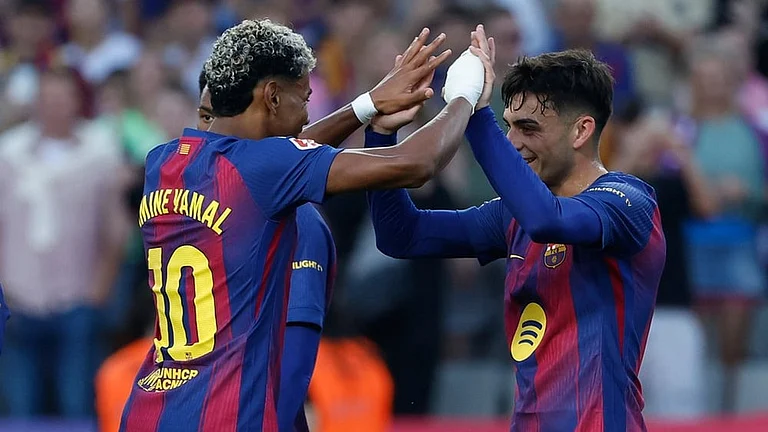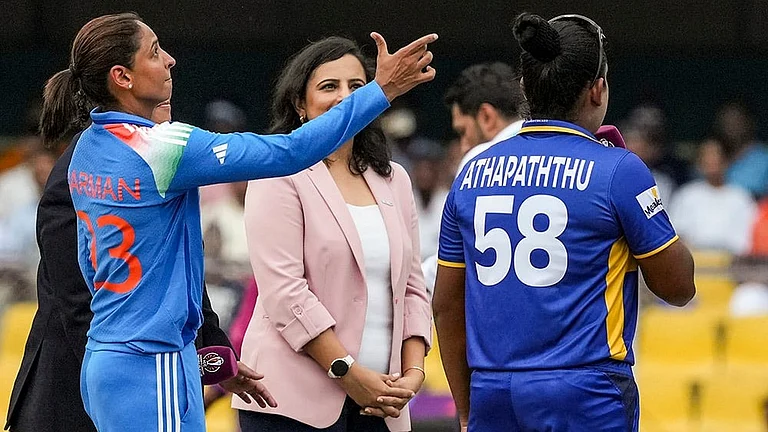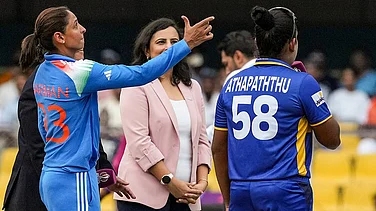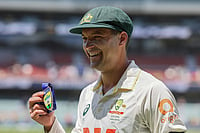ONSIDER the frills: 240 halogen lights of 1,000 watts; six video cameras, live coverage on two cable television channels. Pitch report by Harsha Bhogle. Commentary in English, Hindi and Marathi. Main sponsor: Shogun. Instadia advertising by Pepsi, Britannia, Crush, Amul, Sand Piper. Third umpire for line disputes. Live Kingfisher Band to cheer
spectators. Widescreen television. "Vada-pav!" Now consider the thrills. The venue: Subhash Maidan, not the Wankhede or Brabourne Stadium. The occasion: the Raj Kapoor memorial cricket tournament, not some hip cup or the other. The stars: Vinod Korgaonkar and Vijay Lad, Mangesh Adatrao and Satish Shetty, not Sachin or Azhar, Saurav or Rahul. The attendance: 15,000-20,000 to watch nonentities, not the 500-600 that watch Ranji stars. Total prize money: Rs 3.75 lakh, Rs 1 lakh for the winner.
Welcome to Chembur, where Urbs Prima Indus' three biggest commodities—cricket, commerce and cinema—have converged to create Asia's biggest tennis-ball tournament.
Cut to Bangalore. The Cheetah Cup finals in Rajajinagar. The same attractions. Floodlights. Titan watches for winners. Live commentary in English and Kannada. Pseudonyms for every participant—"Imran Khan comes in to bowl to Sunil Gavaskar." Plus mimickry of international players' actions to keep the crowd in splits.
IT'S the same story in Delhi, Hyderabad, Ahmedabad and Chennai and everywhere else in between and across. The Indian game accidentally discovered by the British has been adapted, localised and corporatised in a manner the Brits wouldn't believe how. Just what, in the name of Lord's, is happening to tennis-ball cricket without any help from the marketing genius of the BCCI?
"A very old tradition in India, dating back nearly 40 years, has post-modernised, English commentary being the link with the past," says cricket historian Ramachandra Guha as the softer version of the game goes corporate. "Tennis-ball cricket has kept pace with the asli version. The technology, the idioms, the symbols have all evolved with the real thing."
As urban space shrinks, ticket prices at stadia go through the pavilion roof and the real game becomes an elitist excursion, organised tennis-ball cricket is emerging as the honourable next best, mixing local excitement with international razzmatazz, amid much social intercourse.
Local businessmen donate money. Local youth organise. Local advertisers ride piggyback. Local networks telecast. Local sponsors foot the bill. Local patrons provide food. Local spectators come for a spot of fun. Local youth get around to do something constructive. Local lights, local cameras. Local action. "Given the unemployment scene, it's essential that the energies and attention of youth are focused on more productive things. Tennis-ball cricket does that. There is no politics in it, no religion," says matinee idol Mithun Chakraborty, the chief patron of the Raj Kapoor memorial tournament.
Result: local bonding. "We've had the same umpires, Satish Kurup and Babrekar for all six years," say Lawrence 'Baba' Rodrigues and Michael Mascarenhas, whose Youth Sports Club first went to Mithun in 1991 for the tournament.
Sure, local dadas, local slumlords, local underworld types have stepped in, but make no mistake. In small grounds under floodlights or in deserted roads under streetlights, tournaments which combine two everlasting relics of the Raj—cricket and tennis—are the rage. At almost no cost. The equipment required is minimal: a couple of bats and a ball. No gloves, no leg guards, no helmets, no wicket-keeping gloves, no spikes. The best often play barefoot. Any vacant space will do for a duel. And usually does.
"Everybody is an expert in this form of the game," says Sports Authority of India director Amrit Mathur, who has seen the likes of former India all-rounder Ajay Sharma test their skills in dimly-lit games in the capital's Karol Bagh. "But then, you don't have to be a Test player to play." Those—affordability, accessibility, flexibility and simplicity—are tennis-ball cricket's big pluses. Which is why they are playing it on the beaches on the west coast, in green fields in Andhra Pradesh, on mountain tops in Leh in ever greater numbers. Soccer-mad Calcutta is not quite in the loop.
The formats vary: eight to 11 a side, mostly eight-overs-a-side affairs in Mumbai, 12 in Bangalore. The rules vary: leg-before decisions have been almost eliminated to avoid controversies. But the basic rule doesn't vary: under lights come hell or high water, live and in colour on TV. Variations, if any, are mostly dictated by space. In underarm cricket, the ball is covered with chalk so that the umpire can see exactly where the ball bounces. In tapeball cricket, the ball is wrapped in tape to enable the bowler to gain maximum swing, pace and bounce. Some tournaments use tennis-balls harder than the lawn tennis ones. Others features thinner stumps.
Such is the increasing interest and involvement, organisers of the really big tournaments have jacked up entry fee from a once-upon-a-time Rs 50 a side to Rs 1,500-2,000 to keep out non-serious contenders. One Mumbai tournament charges Rs 5,000 per team.
Although the entry fee is a bit daunting for unemployed youth,the prize money is a big catch. Mathur says some states pay Ranji players Rs 250 a day. Contrast this with tennis-ball cricket. In Gujarat, winners ride away in Marutis. "I once gave away a colour TV set for a man of the match. When I asked him what he would do with it, he said wistfully he would sell it away, to whip up some cash for his sister's marriage," recalls Chakraborty.
A Bangalore team has two Omnis—bought with prize money—to crisscross the state in and earn some more.But, it's perhaps the sense of participation that tennis-ball cricket gives its players which accounts for its burgeoning popularity.
Across the subcontinent, too, it's growing. In Cricket: A Pilgrimage, Emma Levine talks of the Lahore Challenge tennis-ball night tournament, Pakistan's biggest, in which 265 teams take part and matches are held on four different grounds simultaneously. Mithun's plans to invite a Pakistani team to come to Chembur have been temporarily put in deep freeze.
For the bank employees of Triplicane, for the overworked Udupi hotel hands of Nariman Point, for the computer engineers of Ban-galore who spend their waking, working hours oohing and aahing at Sachin, Shane and Waqar, the humble tennis-ball—usually second hand, the refuse of the local tennis court—offers the chance to check out where 'they' stand vis-a-vis 'them' even while they shoulder the regular middleclass burden of earning a livelihood.
With none of the risks. Tennis balls don't kill although it requires as much skill as the harder leather ball for bowling, batting or fielding. Former Bengal captain Arun Lal has for long advised young opening batsmen to practice against a soggy tennis-ball to improve their chances against fast bowlers.
And in Portrait of a Hero, Clifford Narinesingh says Sunil Gavaskar's sustained defence of his mother's tennis-ball bowling is what disciplined the little master's batting in the long run. In the confines of their Dadar colony, Gavaskar cut out loose, careless, aggressive shots, that earned him 10,122 Test runs in the end.
"Tennis-ball cricket demands sharp reflexes from batsmen because the ball comes on so fast to the bat, encouraging straight hitting. And the lightness of the ball demands subtlety from bowlers and anticipation from fielders," says former India reserve R. Sudhakar Rao. "Besides, it's so frenetic, it keeps you fit."
BUT the requirements of the two forms of the game are different. Bowlers, for instance, squeeze the ball at the moment of delivery, making its trajectory and movement off the pitch unpredictable. Batsmen can't loft for fear of holing out. So they concentrate on running between the wickets. "Leather-ball cricket is about patience—persevering for a wicket or waiting for a bad ball. Tennis-ball cricket is all about fleetfootedness and quicksilver fielding. The temperaments required are different," says K. Mahesh Kumar, a Bangalore tennis-ball ace.
Kumar played for five years for a team called Jai Karnataka before the demands of his printing press beckoned him. Today, the team, founded by Vinayaka Rao, an officer in the accountant-general's office, 20 years ago, is the state's champion side. Comprising mostly of youth between 15 and 25, and based in the Yeshwantpur-Peenya industrial belt, it boasts an 'A' and a 'B' team which practise every day and zip around in a hired van for tournaments. Anybody can join the teams by paying a Rs 10 enrollment fee.
Among those who have donned Jai Karnataka's customised track suit is David Johnson, the Anglo-Indian fast bowler who played against Australia last year. In Mumbai, stars like Praveen Amre and Abey Kuruvilla, Lalchand Rajput and Chandrakant Pandit are regulars on the tennis-ball circuit. Anil Kumble started out as a fast bowler and Dodda Ganesh as a batsman in this form.
"It is the Achrekar generation not Gavaskar generation which is playing more," says cricket writer Hemant Kenkre. "In the old days everybody started with tennis-ball and graduated to leather-ball, but now there are tennis-ball specialists and leather-ball specialists and the twain shall not meet." Vinod Korgaonkar has already entered tennis-ball lore, and his portly frame has earned him the nickname 'Gol Bandya' a la Arjuna Ranatunga.
Sudhakar Rao, who played tennis-ball cricket with G.R. Vishwanath even after entering the first-class scene, predicts big time for the softer version: "I've watched a lot of these matches under lights and am amazed at its evolution. Its short duration and high entertainment will give it a national colour later if not sooner." Crowd pressure to get on with the game ensures there's little wastage of time, and innings are completed in between 30 and 45 minutes. In Mumbai, teams are fined upwards of Rs 1,000 for delays eating into cable TV airtime! Bowlers who chuck are penalised three runs for every violation. "Discipline must be observed to the utmost," exhorts commentator Milind Wagle. Live! And the entertainment comes not just from the stupendous fielding or running between the wickets, but from the glamour of rubbing shoulders with the bold and beautiful.
Juhi Chawla one night, Jackie Shroff the next. Shilpa Shetty one night, Sunil Shetty the next. Amitabh Bachchan one night, Kapil Dev the next. "But perhaps, when all is said, the secret of the spell of cricket lies in the possibilities of every ball. The bat awaiting the ball is indeed an implement of destiny, but the ball which the bat awaits is more fateful. In its flight through the air, after it has left the bowler's hand and before it reaches the batsman, the spectator can live a lifetime." (E.V. Lucas, English Leaves, 1933) Say it again for tennis-ball cricket as karma-conscious Indians lock horns with fate in a more user-friendly form of the game.






















